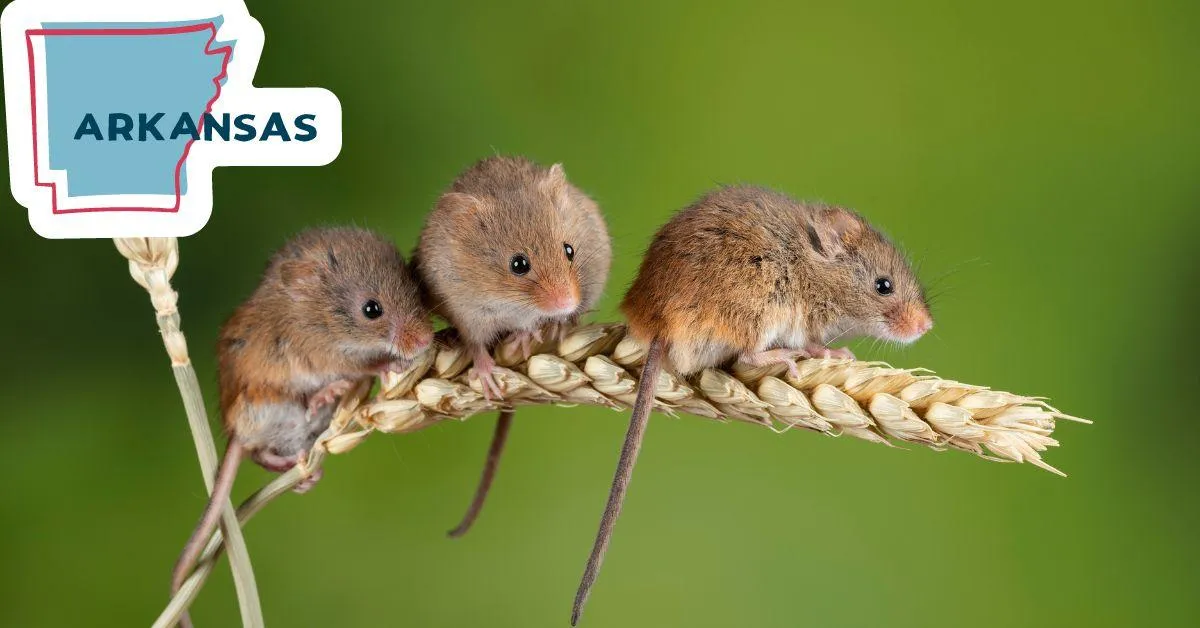Blog
Explore insightful and informative pest control blogs

Are Mice a Concern in Northwest Arkansas?
If you're living in Northwest Arkansas, it's natural to wonder if mice are a concern. After all, they are small and cute which can make them seem like no big deal. But there's a reason mice are considered pests and they can definitely be a threat to your home or business. This article will discuss why mice can be a concern in the region along with some ways you can prevent or manage any potential issues.
Understanding Mice in Northwest Arkansas
Mice are ubiquitous rodents found not only in Northwest Arkansas but across the United States. Understanding the different species of mice in this region and their behavior and characteristics is crucial for homeowners and residents to effectively deal with potential infestations. In this section, we delve into the specifics of mice in Northwest Arkansas.
Common Mouse Species
Deer Mice (Peromyscus maniculatus)
Appearance: Deer mice typically have a brownish-gray fur with a white underbelly.
Habitat: They are commonly found in rural and forested areas, including the Ozark Mountains.
Behavior: Deer mice are known for their excellent climbers and can be found both indoors and outdoors.
Distinguishing Traits: Prominent large eyes and relatively long tails.
House Mice (Mus musculus)
Appearance: House mice are small, gray rodents with relatively large ears and a long, nearly hairless tail.
Habitat: These mice thrive in human-made structures like homes, businesses, and agricultural buildings.
Behavior: House mice are notorious for their ability to adapt to various environments.
Distinguishing Traits: Small size and a pointed snout.
White-Footed Mice (Peromyscus leucopus)
Appearance: White-footed mice have a light-brown to grayish-brown fur and, as the name suggests, distinctive white feet.
Habitat: They are often found in woodlands, grasslands, and shrublands.
Behavior: White-footed mice are primarily nocturnal and excellent jumpers.
Distinguishing Traits: White underparts and their unique white feet.
Behavior and Characteristics
Understanding the behavior and characteristics of mice is essential in assessing the potential risks they pose and how to effectively manage them.
Habitat
Indoors: Mice often seek shelter in homes, attics, basements, and crawl spaces.
Outdoors: Some mice species prefer natural habitats like fields, woods, and grasslands.
Behavior
Nocturnal: Most mice are nocturnal, meaning they are most active during the night.
Omnivorous Diet: Mice have a varied diet, including grains, seeds, insects, and even small invertebrates.
Reproduction: Mice can reproduce quickly, with some species producing multiple litters in a year.
Nesting Habits: Understanding where mice build their nests is crucial for effective control.
Distinguishing Traits
Tail Length: The length of a mouse's tail can be a key distinguishing feature.
Coloration: Differences in fur color and patterns can help identify specific species.
Behavioral Patterns: Some mice exhibit distinct behaviors, like burrowing or climbing.
By gaining a deeper understanding of the common mouse species in Northwest Arkansas and their behavior and characteristics, you'll be better equipped to identify potential infestations and take proactive measures to prevent or address them. In the following sections, we will explore the impact of mice on homeowners and effective strategies for prevention and control.
Impact on Homeowners

Property Damage
Mice may appear small and harmless, but they are far from it when it comes to property damage. These tiny rodents have a knack for causing extensive harm to homes and belongings.
Chewing Habits: Mice have continuously growing teeth, and to keep them at a manageable length, they chew on just about anything they can find. This includes electrical wiring, insulation, wooden structures, and even personal items.
Structural Damage: In cases where mouse infestations are left unchecked, the structural integrity of your home can be compromised. Gnawed wires can pose fire hazards, while chewed insulation can lead to energy inefficiency and higher utility bills.
Damage Assessment: If you suspect a mouse infestation, it's essential to assess the damage promptly. Look for signs of chewed materials, gnaw marks, and any unusual behavior in your home.
Health Concerns
Beyond property damage, mouse infestations can pose significant health risks to homeowners and their families.
Disease Transmission: Mice are known carriers of various diseases, including Hantavirus and Salmonella. Their droppings, urine, and saliva can contain harmful pathogens that, when inhaled or ingested, can lead to serious illnesses.
Allergens: Mouse allergens, primarily found in their droppings and urine, can trigger allergies and respiratory problems in sensitive individuals. Symptoms can range from sneezing and coughing to more severe reactions.
Preventive Measures: To protect your family's health in case of an infestation, it's crucial to act swiftly. This includes proper cleaning and disinfection of affected areas, using personal protective equipment (PPE), and seeking medical attention if you suspect exposure to mouse-borne diseases.
Food Contamination
Mice pose a direct threat to your food supplies. They are notorious for contaminating stored food, posing risks of foodborne illnesses.
Contaminated Food: Mice can infiltrate your pantry, cabinets, and food storage areas. They leave behind droppings, urine, and hair, contaminating the food items they come into contact with.
Foodborne Illnesses: Consuming food that has been contaminated by mice can lead to foodborne illnesses. These illnesses can range from mild gastrointestinal discomfort to more severe conditions, such as food poisoning.
Safe Storage Practices: To safeguard your food, always store it in airtight containers. Inspect food items for signs of tampering or contamination, and promptly dispose of anything suspicious.
Seasonal Mouse Activity
Seasonal Variations
Mouse behavior in Northwest Arkansas varies with the changing seasons, impacting their presence and activity in and around your home.
Winter Behavior: During the colder months, mice seek shelter indoors. Your home provides warmth and protection from the elements, making it an attractive option for them.
Spring and Summer Behavior: As the weather warms up, mice become more active outdoors. They may venture inside less frequently but can still be a concern, especially if they find food sources indoors.
Peak Activity Times
Understanding when mice are most active can help homeowners be vigilant and take necessary precautions.
Dusk and Dawn: Mice are crepuscular creatures, meaning they are most active during dawn and dusk. These are times when you might hear them scurrying or notice signs of their presence.
Breeding Seasons: Mice have multiple breeding seasons throughout the year. These times can lead to population surges, making infestations more likely.
Identifying Mouse Infestations

Recognizing the signs of a mouse infestation is crucial for taking prompt action and preventing the problem from worsening.
Droppings and Tracks: Mouse droppings are small, pellet-like, and often found near food sources or nesting areas. Look for tiny tracks in dusty or less-frequented areas of your home.
Gnaw Marks: Mice have a distinctive gnawing pattern. Check for gnaw marks on wooden surfaces, electrical wires, and other materials.
Unusual Noises and Smells: Pay attention to any unusual scratching or rustling sounds coming from walls or ceilings. Additionally, a strong, musty odor may indicate the presence of a mouse nest.
Common Entry Points
Mice are resourceful when it comes to finding ways into your home. Identifying common entry points is essential for effective prevention.
Cracks and Gaps: Inspect your home for cracks and gaps in the foundation, walls, and windows. Even small openings can provide access for mice.
Doors and Windows: Check the seals around doors and windows for any gaps or damage that mice could exploit.
Utility Openings: Mice can enter through utility openings, vents, and gaps around pipes. Ensure these areas are adequately sealed with appropriate materials.
Nesting Areas
Understanding where mice tend to nest within your home is crucial for effective control.
Attics and Basements: Mice often seek shelter in attics and basements, where they can build nests in insulation or stored items.
Wall Cavities: Wall voids provide a hidden nesting spot for mice. They can access these areas through gaps in the walls.
Storage Areas: Cluttered storage spaces offer mice places to hide and build nests. Regular decluttering can help prevent infestations.
Preventing Mouse Infestations: Homeowner Tips
Landscaping Tips
Landscaping can play a significant role in deterring mice from your property in Northwest Arkansas. Removing attractants and creating an environment that is less hospitable to mice is essential. Start by clearing tall grass, weeds, and debris that can serve as hiding places for mice. Trim tree branches and shrubs away from your home to eliminate potential bridges that mice could use to access your property. Also, make sure to secure compost bins, as they can attract mice looking for food sources.
Regular Inspections
Routine inspections are a crucial part of mouse prevention. By conducting visual checks of both the interior and exterior of your home, you can catch potential issues early. Look for signs of mouse activity, such as droppings, gnaw marks, or any unusual behavior in and around your home. Early detection allows for swift action, preventing infestations from taking hold.
Education
Understanding mouse behavior and habits is fundamental to proactive prevention. Take the time to learn about common mouse behaviors, such as nesting and foraging patterns. Knowledge is a powerful tool for homeowners to make their properties less inviting to mice. By knowing what attracts and sustains mouse populations, you can take steps to eliminate those factors.
Sealing Entry Points
Effectively sealing entry points in your home is a critical aspect of mouse prevention. To get started, you'll need a few essential materials:
Materials Needed
Caulk: High-quality caulk is essential for sealing small gaps and cracks in your home's structure.
Weatherstripping: Weatherstripping is useful for sealing gaps around doors and windows.
Mesh Screens: Installing mesh screens over vents and openings is essential to keeping mice out.
Steel Wool: Steel wool can be used to block larger gaps, as mice cannot chew through it.
Step-by-Step Guide
To seal common entry points effectively, follow these steps:
Identify Entry Points: Begin by identifying potential entry points in and around your home. Common areas include gaps in doors, windows, foundation walls, and utility openings.
Clean and Prepare: Before applying sealant, clean the area around the entry point to ensure proper adhesion. Remove any dirt, dust, or debris.
Apply Caulk: Use caulk to seal small cracks and gaps. Apply a continuous bead of caulk along the opening, ensuring it is well-sealed.
Install Weatherstripping: Apply weatherstripping around doors and windows to prevent mice from squeezing through small gaps.
Secure Mesh Screens: Install mesh screens over vents and openings, ensuring they are securely fastened to prevent mice from entering.
Steel Wool Barriers: For larger gaps, stuff steel wool into the openings. Mice cannot chew through steel wool, making it an effective barrier.
Proper Food Storage
Proper food storage is crucial in preventing mice from accessing your food supplies. Two key methods for ensuring food safety are:
Airtight Containers
Recommend using airtight containers for food storage. Airtight containers prevent mice from accessing stored food and keep it fresher for longer. Store items like cereals, grains, and snacks in these containers to safeguard your food.
Elevating Food
Encourage homeowners to store food off the ground by using shelves or raised storage. Mice are less likely to access food that is elevated, reducing the risk of contamination. Additionally, use plastic or metal containers with secure lids to store food items in pantries and cabinets.
Maintaining a Clean Home
A clean and clutter-free home is less appealing to mice. Here are some cleaning tips to help prevent mouse infestations:
Cleaning Routines
Establishing regular cleaning routines is essential. Clean up food debris and crumbs promptly, as these can attract mice. Regularly sweep, mop, and vacuum your home, paying extra attention to areas where food is prepared or stored.
Garbage Management
Proper garbage disposal is critical in deterring mice. Make sure outdoor garbage bins have tight-fitting lids to prevent mice from accessing food waste. Empty garbage bins regularly, especially those containing food waste. If you compost, use a well-sealed compost bin to prevent attracting mice to your compost pile.
Natural Deterrents

In Northwest Arkansas, eco-friendly methods can be employed to deter mice from your property:
Planting Deterrents
Consider planting herbs and plants that mice dislike around your home:
Mint: Planting mint around the perimeter of your home can act as a natural deterrent, as mice find its scent unpleasant.
Lavender: Lavender emits a scent that mice tend to avoid.
Natural Predators
Harness the power of natural predators to keep mice at bay:
Owls and Hawks: Encouraging the presence of owls and hawks in your area can help control mouse populations, as these birds are natural predators.
Cats: If you're a cat owner, your feline companion can serve as a natural deterrent by hunting and deterring mice from your property.
Use of Repellents
Natural repellents can be an effective way to keep mice away:
Peppermint Oil
Peppermint oil is a well-known mouse repellent:
Application: Soak cotton balls in peppermint oil and place them in areas prone to mouse activity.
Refreshing: Refresh the peppermint oil periodically to maintain its effectiveness.
Ultrasonic Devices
Ultrasonic repellent devices emit high-frequency sounds that are uncomfortable for mice but inaudible to humans:
Operation: These devices emit ultrasonic waves that deter mice from staying in the area.
Placement: Place ultrasonic devices in rooms or areas where mouse activity has been observed for optimal results.
Using natural deterrents can help create an environment that is less inviting to mice, reducing the risk of infestations in your Northwest Arkansas home.
If you've tried these prevention methods and still face persistent mouse problems, it may be time to consider professional pest control services in your area. Let's explore when it's appropriate to call in the experts and compare some local options.
Professional Pest Control Services

Calling professional pest control services may be necessary in certain situations:
Severe Infestations
When faced with severe infestations, it's best to leave the job to experts:
Risk Mitigation: Professional pest control can effectively mitigate health risks and property damage associated with severe infestations.
Expertise: Pest control professionals have the knowledge and tools to address extensive infestations comprehensively.
Persistent Problems
If you've experienced recurring mouse infestations despite your best efforts, it's time to consider professional help:
Recurring Infestations: Frequent infestations may indicate underlying issues that require professional assessment and treatment.
Complex Cases: Some infestations may involve complex nesting locations that homeowners are unable to access.
Don't let pests put a damper on your Northwest Arkansas lifestyle - Network Pest Control has the most effective, safe and environmentally friendly methods to get rid of your pest problem - fast! Contact us today for a free consultation or inspection and take back control of your home and business!
Craving a Superior Pest Control Solution?
COMPANY STORY
& EXPERIENCE
Craig Broadhead started his pest business in 2004 in California, called Pacific Pest Control. In 2021, he sold his business and moved his family to Arkansas to start fresh with a new vision of Network Pest Control. His goal it to make sure each customer has the best experience possible.


Network Pest Control
11205 Meadow Lark Rd. Rogers AR 72756
479.888.4249
